Radio Round-Up
Greetings, gate! Today on Radio Round-Up, we present references to Bob Hope’s radio show in classic animated cartoons, including “Professor” Jerry Colonna…

Though he had performed on vaudeville and Broadway in the early part of his show business career, Bob Hope made a nation-wide impact when he appeared on The Fleischmann’s Yeast Hour, starring Rudy Vallee, as a “promising new comic” in 1933. In addition to his film roles and Broadway performances (in such productions as “Roberta” and “Red, Hot and Blue”), he starred in various short-lived radio programs on NBC and CBS from 1935 to 1938.
In one of his early radio appearances on Town Hall Tonight with Fred Allen (May 27, 1936), Jerry Colonna performed a comic rendition of “The Road to Mandalay” accompanied by prolonged, screeching high notes. In The Kraft Music Hall hosted by Bing Crosby, which he played trombone in the John Scott Trotter band, an opera parody was written for Colonna to perform an aria in the same manner. This routine was carried over in the Paramount musical comedy College Swing (1938), as he recited the Bing Crosby song “Please”. While he delivered comic monologues for the weekly program, Bob Hope was simultaneously performing in College Swing, where he discovered Colonna’s comedic sensibilities in person.
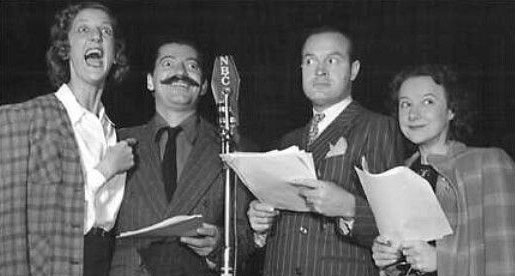
Elvia Allman (“Cobina”), Jerry Colonna, Bob Hope and Blanche Stewart (“Brenda”)
Pepsodent toothpaste considered ending their association with the Amos n’ Andy program in favor of a new show for the fall 1938 season. Hope was picked to star in The Pepsodent Show, which first aired on NBC in September 27th, recruiting Colonna as his sidekick. In his featured appearance on the first Pepsodent broadcast, he is introduced with an extended opening wail of the song “Ah! Sweet Mystery of Life” before trading quips with Hope. Their sketch concluded with Colonna reprising his hammy rendition of “The Road to Mandalay” from Town Hall Tonight. Colonna, or “Professor” as Hope often addressed him, became a hit on the program, with his salutation “Greetings, Gate!” becoming a national catchphrase.
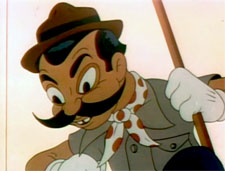
From “Greetings Bait”
Besides his signature catchphrases, Colonna’s vocal mannerisms and wide-ranging moustache started to be referenced in animated cartoons just as The Pepsodent Show gained recognition in its first season. The tough convict in Bars and Stripes Forever (WB/1939) sings the Johnny Mercer/Harry Warren tune “Daydreaming (All Night Long)” as he casually makes a prison escape, holding high notes in the vein of Colonna. Later, Friz Freleng directed two cartoons featuring a worm based around Colonna—mustache included: The Wacky Worm (1941) and Greetings Bait (1943), the latter film nominated for an Academy Award.
During its second season in fall 1939, The Pepsodent Show added Blanche Stewart and Elvia Allman to the cast as Brenda and Cobina, lampooning spoiled New York socialites Brenda Frazier and Cobina Wright, Jr. Elvia Allman was a veteran of roles in animated short films, coincidentally voicing a love-starved old bird vying for the iceman’s affections in Tex Avery’s I Only Have Eyes For You (1937), which predated her character on Hope’s show. Each of their conversations on the program would begin with Cobina calling to Brenda, to which her friend would reply, “What is it, Cobina?” Again, many of the 1939-40 broadcasts from The Pepsodent Show have not survived, so it is unknown if either of the two characters explicitly shouted “Look, a man!” as a small number of cartoons have depicted. In the Screen Gems cartoon Cinderella Goes to a Party (1942), the film opens with Cinderella’s two stepsisters readying themselves for the royal ball, speaking in voices patterned after Brenda and Cobina.
Around early 1941, Old Gold cigarettes changed its slogan to “Something new has been added” when it switched to the J. Walter Thompson ad agency. Advertisements stated Latakia tobacco enriched the overall quality of tobacco in this latest incarnation of the brand. This slogan became synonymous with Jerry Colonna as he often used it as a reliable capper during his verbal exchanges with Hope. In a number of animated films, characters spoke the line with Colonna-esque intonations, such as The Hep Cat (WB/1942) and Plane Daffy (WB/1944). Tex Avery also utilized the phrase, underneath a buzzing neon sign displaying the film’s title, to emphasize a contemporary take on an old-fashioned fairy tale, Red Hot Riding Hood (MGM/1943).
Bob Hope was infrequently caricatured in animated cartoons, though a couple such as the Little Lulu cartoons The Baby Sitter and A Bout with a Trout (both 1947) feature Hope and Colonna together; like Little Lulu, Hope was associated with Paramount Pictures. Based on the popularity of the Road comedies, where Hope was paired with Bing Crosby, the two appear in Kitty Caddy (1947), both voiced by Dave Barry.
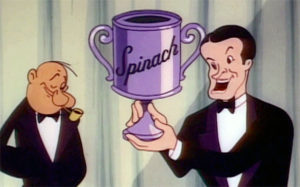 Bob McKimson’s second Warners film as a director, Hollywood Canine Canteen (1946) is rife with dog versions of film and radio personalities, including a brief appearance by Hope and Colonna performing a radio sketch with wordplay undoubtedly inspired, if not directly lifted from The Pepsodent Show (“Professor, you get under my skin.” “Ahhh, no—you get under mine. More room.”)
Bob McKimson’s second Warners film as a director, Hollywood Canine Canteen (1946) is rife with dog versions of film and radio personalities, including a brief appearance by Hope and Colonna performing a radio sketch with wordplay undoubtedly inspired, if not directly lifted from The Pepsodent Show (“Professor, you get under my skin.” “Ahhh, no—you get under mine. More room.”)
While Colonna was imitated many times in animated shorts, Walt Disney hired the man himself as the narrator for “Casey at the Bat,” intended as a segment for the package feature Make Mine Music (1946). He narrated on another short for Disney, The Brave Engineer (1950), which recounted the ballad of Casey Jones. In perhaps one of his celebrated roles on film, Colonna provided the voice of the March Hare for Alice in Wonderland (1951). The NBC television show Ford Star Revue aired a promotional featurette “Operation Wonderland” a month before the film’s July 1951 premiere, which featured Colonna on-screen in live-action reference footage for the Mad Tea Party sequence.
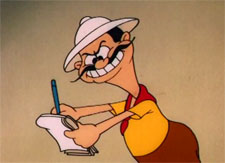 By 1948, ratings had plummeted on The Pepsodent Show and Hope needed an overhaul on his NBC program. That fall, he starred in The Swan Show Starring Bob Hope, now sponsored by Swan Soap. One noteworthy change to the show was the absence of Colonna, as many of the previous cast members did not appear on the new show. However, Colonna occasionally appeared with Hope during the early 1950s, now re-titled The Bob Hope Show, including the final episode, which aired on April 21st, 1955. Even after a massive stroke in 1966, which paralyzed his left side, Hope and Colonna continued to work together on his television shows, on-camera and behind the scenes, as his co-star gave input to the scripts and musical scores. Colonna suffered a heart attack in 1977, after which he remained at the Motion Picture and Television Hospital until his death in 1986.
By 1948, ratings had plummeted on The Pepsodent Show and Hope needed an overhaul on his NBC program. That fall, he starred in The Swan Show Starring Bob Hope, now sponsored by Swan Soap. One noteworthy change to the show was the absence of Colonna, as many of the previous cast members did not appear on the new show. However, Colonna occasionally appeared with Hope during the early 1950s, now re-titled The Bob Hope Show, including the final episode, which aired on April 21st, 1955. Even after a massive stroke in 1966, which paralyzed his left side, Hope and Colonna continued to work together on his television shows, on-camera and behind the scenes, as his co-star gave input to the scripts and musical scores. Colonna suffered a heart attack in 1977, after which he remained at the Motion Picture and Television Hospital until his death in 1986.
As always, this video should illustrate the impact of Bob Hope’s radio show, especially Jerry Colonna’s remarkable talents. As usual, this may not include every instance a certain reference or caricature depicted in animated cartoons; some were mentioned in the column but not included due to shorten the duration of the video. (Somehow, I missed a reference to the Lifebuoy soap commercial in the Famous Studios Noveltoon, Pleased to Eat You and the Lucky Strike auctioneer spiel in the Lantz cartoon Hysterical High Spots in American History…)
Clips included
Colonna high-pitched wail/vocal imitation—Prehistoric Porky (WB/1940), Detouring America (WB/1939), Cinderella Goes to a Party (Screen Gems/1942), Pleased to Eat You (Famous/1950), The Wacky Worm (WB/1941)
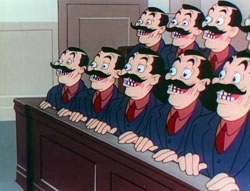 “Greetings, Gate!”—Scalp Trouble (WB/1939), The Wise-Quacking Duck (WB/1943), What’s Cookin’ Doc? (WB/1944)
“Greetings, Gate!”—Scalp Trouble (WB/1939), The Wise-Quacking Duck (WB/1943), What’s Cookin’ Doc? (WB/1944)
Brenda and Cobina—Goofy Groceries (WB/1941), Eatin’ on the Cuff (WB/1942), Hysterical Highspots in American History (Lantz/1941)
“Haven’t I/Isn’t it?”/more vocal imitations—The Duckators (WB/1942), Mother Goose on the Loose (Lantz/1942), Who Killed Who (MGM/1943, voiced by Kent Rogers), The Unruly Hare (WB/1945), Daffy Doodles (WB/1946)
References to “Yehudi”—Farm Frolics (WB/1941), Hollywood Steps Out (WB/1941), Crazy Cruise (WB/1942)
“Something new has been added!”—The Hep Cat (WB/1942), Plane Daffy (WB/1944), Booby Traps (WB/Snafu, 1943), with the ending scene from Greetings Bait (WB/1943)
(Thanks to Keith Scott and Eric Costello for their help.)


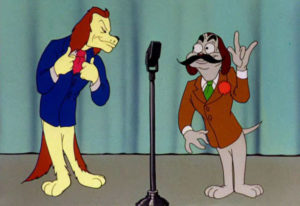
 DEVON BAXTER is a film restoration artist, video editor, and animation researcher/writer currently residing in Pennsylvania. He also hosts a
DEVON BAXTER is a film restoration artist, video editor, and animation researcher/writer currently residing in Pennsylvania. He also hosts a 





















































































It’s a scientific fact that having a Jerry Colonna reference or impersonation improves a cartoon by at least 10%. My personal favorite is the “Something new has been added!” in The Hep Cat.
Don’t forget Department:
Jerry Colonna also did another for Disney, THE WHALE WHO WANTED TO SING AT THE MET, in MAKE MINE MUSIC.
That was actually Nelson Eddy providing all the voices and singing for that segment.
No, that was Nelson Eddy.
He actually did for “Casey at the Bat”, a segment in “Make Mine Music”, which was directed by Jack Kinney.
Moreover, he provided the narration on the cartoon “The Brave Engineer”, a story about Casey Jones in 1950.
THanks, I remember. I meant Nelson Eddy did the voices, to my memory, and did some others, for DIsney, at least,too. TIny Toons and the others other like Animanioacs only use, generally contemporary, and as I said, of such, blander, references (I must be the only one not a fan who APPRECIATES< the m ain trio's Marx Bors.refernces though.)
Am invalueable and indepth post! Loved it… and thank YOO
The extent to which classic Hollywood cartoons cribbed from radio programs is huge…it opens up a moral question. Was this plagiarism? The motion picture studios profited off the use of these catch-phrases, and their lineage was well-known by, I’d wager, the majority of audiences who saw these cartoons first-run. The realization of how much material was “borrowed” from radio comedy (and, to a lesser degree, film comedy) makes it hard to see these cartoons as I once did. I still love them, but their reliance on so much material from radio makes me question the morality of it all. The writers of the gags probably got paid once for coming up with them, while sponsors, networks and stars of the programs profited… and they received zilch for these widely spread cartoon “quotations,” which were part of revenue streams for motion pictures, animation studio employees, etc.
Then there’s the issue of the wholesale appropriation of a radio character and their persona. So many popular characters are baldly based on existing radio and movie personalities. Some directors went to the source, as did Tex Avery with Wally Maher and Bill Thompson, but most used a mimic to recreate a recognizable voice–and that was the character. To Mel Blanc’s credit, he balked at copping Art Carney’s voice for the Barney Rubble character on “The Flintstones.” But few others hesitated to wholly borrow another performer’s schtick for use in cartoons… often for years, as a series ran.
These articles make me realize how unoriginal the content of much of Hollywood animation truly is. It’s a bit dismaying to realize this. It’s difficult for me to see them as the creative firebrands I once thought them to be. I don’t think the animators sought to rip off radio writers and personalities… they were reflecting the pop culture zeitgeist of their times in many ways. But without all these borrowings, the cartoons would have very little in terms of original humor and characterization.
I’m sure these musings will enrage some animation fans, but Devon’s articles have really opened my eyes to the high percentage of using others’ work that comprises the classic Hollywood (and East Coast) theatrical cartoon.
So, what’s wrong with referring other topical things? I never consider that unoriginal.
It’s a little thing called “Pop Culture References”. Today’s media does the same thing except AM radio doesn’t do comedy or fiction anymore. That’s one thing how Tiny Toons and Animaniacs kept the spirit of the Looney Tunes
I’m sure when these things were made, people didn’t really think of the future as we are now, at least the way we look back at these things. I’m sure for the writers, animators and so-on, it was just another paycheck and a short ready for the package. Radio at that time was a very viable and instant medium at at time when all we had was just that, along side movies, newspapers, magazines and books. Using pop culture in an short subject like a cartoon was probably not looked at the same we we do these days, especially when it came to topical humor. Shorts typically weren’t seen on repeat the way television made it possible, and people probably didn’t think of how often these things came and went. I suppose originality in producing shorts didn’t come as easy as it was common to be inspired by what was out currently out there in the media.
Hi Frank,
I don’t find it enraging that cartoons borrowed so much from the golden age of radio. As a kid, I found these references very funny, without knowing what the origins of the characters or catchphrases really were. These cartoons created curiosity, just what did they mean by “Greetings, Gate!”, “Who’s Yehudi?” or “Ah yes, something new has been added!” When I found out that these sayings all came from Professor Colonna and the Bob Hope radio show, it gave me new respect for these comedians. The cartoons helped to perpetuate the comedy of Jerry Colonna, Elvia Allman, Joe Penner, Al Pearce and many more. We only know them today, BECAUSE the cartoons borrowed from their radio shows. By the way, most of the Jerry Colonna voices in the clips that Devon posted were done by Mel Blanc (the man of 1000 voices who NEVER IMITATED ((oh yeah?))) Only the Colonna jury in “Daffy Doodles” seems to be another mimic or mimics. So don’t despair, Frank, instead REJOICE that we still can recognize these old comedy lines, thanks to cartoons. Ah YES! Something OLD has been added!
I would side with Mark on this one. Without these cartoons, those familiar phrases and such would’ve died out alongside the medium that made them popular.
I also agree with Mark. I also might add that for me, finding out the background and origin of the comedy bits and catchphrases make the cartoons that much more enjoyable for me. Instead of thinking, “Oh, that’s funny.” Now I can say, “Wow! Now I get it!”
I love cartoons with caricatures. It’s fun to see just how many people and bits I recognize.
The Simpsons episode THE DAY VIOLENCE DIED addressed a very similar point in a somewhat humorous tone.
Not to mention that modern animated sitcoms like The Simpsons and Family Guy have done pop culture references the same way that the Golden Age cartoons did. Is it plagarism? Not really. Is it unoriginal? If it’s done right, who cares?
That form of comedy is only funny for a short time, but it becomes a valuable time capsule.
I also side with Mark, those continued the radio phrases. on Family Guy and Simpsons, the current pop references don’t have, for the most part, the “Golden Age” magic, or distinctive (natural or created) VOICES and phrases..I mean, can anything in the last 20 years stand up to “Greetings Gate!” 😀
The Colonna wail was also heard in RUSSIAN RHAPSODY, when little gremlin hits a big gremlin on the foot.
Jerry was also referenced and caricatured as the invisible man in the Beany and Cecil episode “Phantom of the Horse Opera”.
I also recall hearing an archival screening during a Clampett presentation (it’s in one of the bonus features on the first Beany and Cecil DVD) where Jerry was on the set of a pilot for one of Clampetts’ proposed puppet shows (The Guided Muscle) and as a result they made a tiger puppet a caricature of him.
I’m also reminded of Bugs’ Pagliacci turn in “Acrobatty Bunny”. 🙂
Colonna’s last job before his stroke was a guest-shot on the first episode of production (but eighth to air) of a cartoonish live-action series, The Monkees (“Don’t Look a Gift Horse in the Mouth”).
John Scott Trotter obviously had a penchant for collaborating with walrus-mustachioed eccentrics – First, with Colonna, and then with composer Vince Guaraldi on the “Peanuts” specials.
By the way, Devon, I have heard on good authority that the Bob Hope family have the acetates of the 1939-40 season of “The Pepsodent Show”, and in fact have the complete radio run of the Hope shows, perhaps not including the earliest shows he did for NBC in 1935 to 1938. Too bad that more recordings of “The Baker’s Broadcast” with Joe Penner don’t survive. There are only eight shows around that I have heard.
I agree that the radio takeoffs were certainly plentiful, Frank. However, I am not bothered by the many topical references…there were as many in The Simpsons & Family Guy with gags and guest voices all through those show’s seasons…and cartoons are essentially a caricaturistic medium. I am convinced it was to solely garner big laughs via recognition, and I always defend the theatrical cartoon era by noting that the films were meant to have a two-run maximum back in their time…never once did the creators dream that TV would re-expose their early efforts, let alone the ongoing technologies of VHS/ Beta, DVD/ Blu-ray and YouTube would further immortalize the old films, potentially into infinity. Articles like this series by Devon are now more invaluable for historical context and knowledge than ever, especially if you also note that the daily radio show creators of the 1930s-50s also never dreamed that unborn collectors would find network reference recordings years later and start a whole hobby now stretching into tens of thousands of radio shows to study, like the old cartoons, for ever. Amazing and heartening for me to see the popularity of old cartoons and radio to a younger generation now.
Especially when you consider that with the advent of .mp3 technology, you can enjoy radio shows very easily, in your car or elsewhere. I have friends that have killed thousands of hours of dull work-time with OTR.
Thanks to everyone for their responses to a pretty wild flyball I hit. (And I never do sports metaphors.) I feel that many of the responders didn’t quite grok what I said, but that’s okay. I still find it a tiny bit dismaying, but that’s just me. I can still appreciate the artistry of the shorts. Warners really got the topical thing out of their system during WWII. I think this is one reason why the 1948-1954 cartoons are so impressive. They are much more generated from the writers and directors’ imagination, and they have a timeless quality.
And none of that could have happened without the foundation work of the cartoons leading up to this peak period. It took a lot of hard work, thinking and trial and error to get from Egghead to the likes of Freleng’s great Bugs and Daffy cartoons of the early 1950s, Chuck Jones’ streak of marvelous cartoons in the same era, and even some of McKimson’s better efforts. We’re lucky to have all of them to enjoy. I hope more of the LT/MM canon will get a proper release on BluRay and continue to amuse (and educate, via all that historical reference) new viewers.
PS: A long-delayed new posting on my Tex Avery at WB blog will be finished soon… apologies for the great gap of time between new posts! I’m semi-retired now, so I oughta have more time to do this project.
I remember other Colonna-enriched lines in WB cartoons, f’rinstance, “Greetings gate, let’s osculate!”